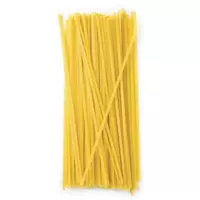Spaghetti

Italy is considered the birthplace of these long, thin pasta, where spaghetti is usually served with tomato sauce. In general, this type of pasta, which the Italians dubbed the word "Pasta, " is characterized by a round section, in diameter are about 2 millimeters, and in length - more than 25 centimeters. Thinner spaghetti is called "spagettini, " and a little more than "spagettoni. " The calorie content of spaghetti is 333 kcal per 100 grams.
Italian chefs prepare a lot of delicious dishes from them, which is why spaghetti is in high demand. Many who have been to this country will never forget "Neapolitan spaghetti" with tomato sauce (Spaghetti Napoli) or spaghetti with hot olive oil and garlic (Spaghetti all'Aglio ed Olio). The two dishes are Italy's most beloved eats, where they are cooked almost every day.
There is another spaghetti-like pasta, but it differs in its lower content of chicken eggs in the dough. Because of this, such spaghetti have a lighter color and are called "fedelini" in their homeland.
In general, the word "spaghetti" in Italian means "twine for tying" or "thread. " It is customary to boil them in salted water, like other types of pasta, but there are a couple of features - they need to be cooked whole in full length, while they cannot be broken. Due to the fact that no ordinary saucepan is able to fully accommodate spaghetti, they are usually placed vertically, and then gradually bent as they soften. Another distinguishing feature is that spaghetti must be brewed "al dente, " i. e. semi-raw. They cannot be boiled, and for this all pasta must be the same length, since the broken appearance violates the cooking rules, which affects the taste of the finished dish.
For dietary nutrition, this type of pasta is not suitable due to the increased calorie content of spaghetti. However, there are varieties made from hard wheat varieties, when consumed, you can not be afraid of extra pounds.
It is customary to enjoy spaghetti with various seasonings and spices, but they are most often eaten with tomato paste and grated cheese. There is even a certain way to eat this hearty dish with a fork and a spoon. The fork must be held in the right hand, and the spoon in the left. Heating spaghetti with a fork, a small portion is pulled out, which is wound up on the device, leaning on a spoon. Then a fork with spaghetti is brought to the mouth, and a spoon is simultaneously taken from the seasoning, which is eaten.
Spaghetti 333 kCal
Energy value of spaghetti (Ratio of proteins, fats, carbohydrates - ju):
Proteins: 11.2 g (~ 45 kCal)
Fats: 1.6 g (~ 14 kCal)
Carbohydrates: 68.4g (~ 274kCal)
Energy ratio (b | y): 13% | 4% | 82%
 Español
Español Français
Français Português
Português Русский
Русский 简体中文
简体中文 繁體中文
繁體中文 日本語
日本語 한국어
한국어 العربية
العربية Türkçe
Türkçe Қазақ
Қазақ Deutsch
Deutsch Italiano
Italiano Українська
Українська
